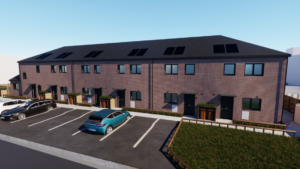Building new homes needs to be about more than meeting targets
 What appears to have become the settled view across the political spectrum is that the nation needs something like 300,000 new homes to be built each year over the next decade.
What appears to have become the settled view across the political spectrum is that the nation needs something like 300,000 new homes to be built each year over the next decade.
Behind that aggregate number there are different takes on the balance between tenure types and market and affordable homes.
But if we look at what the construction industry has produced over the last 40 years you begin to realise quite how big a task this is.
Since 1978 when there were 279,000 homes completed the trend has been unremittingly downward. In the years from 2010 the yearly average is just 151,000 completions, half of what is needed.
Whilst the traditional big volume housebuilders have shown that they alone are unable and sometimes unwilling to get close to the numbers necessary, in recent years there are signs that other players are emerging. Many of the large housing associations have for some time taken on the role of developer, producing market sale housing alongside affordable homes.
This trend accelerated from 2010 when affordable rent at 80% of local market rent was brought in by the coalition government and social rented homes were written out of the script as capital grants were slashed by 60%. It should be noted that several of these housing associations are currently facing difficulties with sales as the market has stalled.
Much more recently and as yet, still at a low level of house building, councils are returning. It will take time to grow the skills, experience and self-confidence to make a really significant impact, but with stable and supportive central government policy behind them I believe that councils can make a vital contribution; I know that many want this.
The third factor I wanted to mention is offsite manufacture of homes. This surely has the potential to be a game-changer not just in terms of output of homes, but also of improving standards, energy efficiency, speed of delivery and revolutionising construction skills.
Factories are opening to produce homes on the kind of assembly line methods that are commonplace across other industries. At present levels, homes produced via offsite manufacture cost around the same as those through traditional build, but when volumes ramp up the marginal cost of production will come down and viability will improve for housing schemes.
There is another and very different obstacle to reaching house building targets and that is local opposition to housing development. It’s easy and lazy to dismiss such opposition as being from dyed in the wool NIMBYs.
If you live cheek by jowl with a proposed housing scheme when your family already experiences long waits to get health care, your child can’t get a place in the nearby school and you have to scramble to get on the bus to get to work (assuming there’s still a semblance of a bus service of course) then the prospect of more people putting additional pressure on these services is something you are likely to shout about.
That’s why it is essential that adequate social and transport infrastructure is put in place alongside the new homes and not some time in the future.
The whole concept of the need for new homes expressed as numerical targets in regional and local plans alienates many in existing towns. Much better that we talk about and deliver thriving communities where people want to live and put down roots for the future. Places that have been created with the local services to support people and where thought has been given to the quality and design of buildings and public realm.One more essential point, a good proportion of the homes built need to be affordable for local communities so that people have the chance to live in the area where they work and have their local connections.
If we can manage this there’s a chance the homes needed can be delivered.















